July 27th, 2018
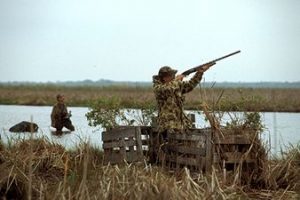
Waterfowl hunting at Guadalupe Delta WMA.
This is Passport to Texas
If you plan on hunting migratory game birds in Texas this fall, you need to be HIP – HIP certified, that is. HIP stands for Harvest Information Program.
It’s purpose is to gain information on waterfowl and migratory bird hunters nationwide. Basically a name and address and a little bit about their previous year’s hunting activity—as well as what they plan on hunting what they plan on hunting in the upcoming year.
Kevin Kraai is Waterfowl Program Coordinator. He says the HIP program helps wildlife professionals improve resource management practices as well as track various waterfowl populations throughout the country.
It’s a very useful tool in setting the future year hunting regulations and management decisions.
Being a HIP certified waterfowl hunter isn’t just a good idea—it’s the law.
Officially it is a requirement by law that every individual that plans on hunting migratory birds in the state of Texas us HIP certified. If you are not HIP certified and you are hunting migratory game birds, you are subject to game violations.
We have a link to information about becoming HIP certified at passporttotexas.org.
The Wildlife and Sportfish restoration program supports our series and is funded by your purchase of fishing and hunting equipment and motorboat fuel…
For Texas Parks and Wildlife…I’m Cecilia Nasti.
Posted in Duck, Hunting, Regulations | Comments Off on You Have to be HIP (Certified) to Hunt Ducks
July 26th, 2018
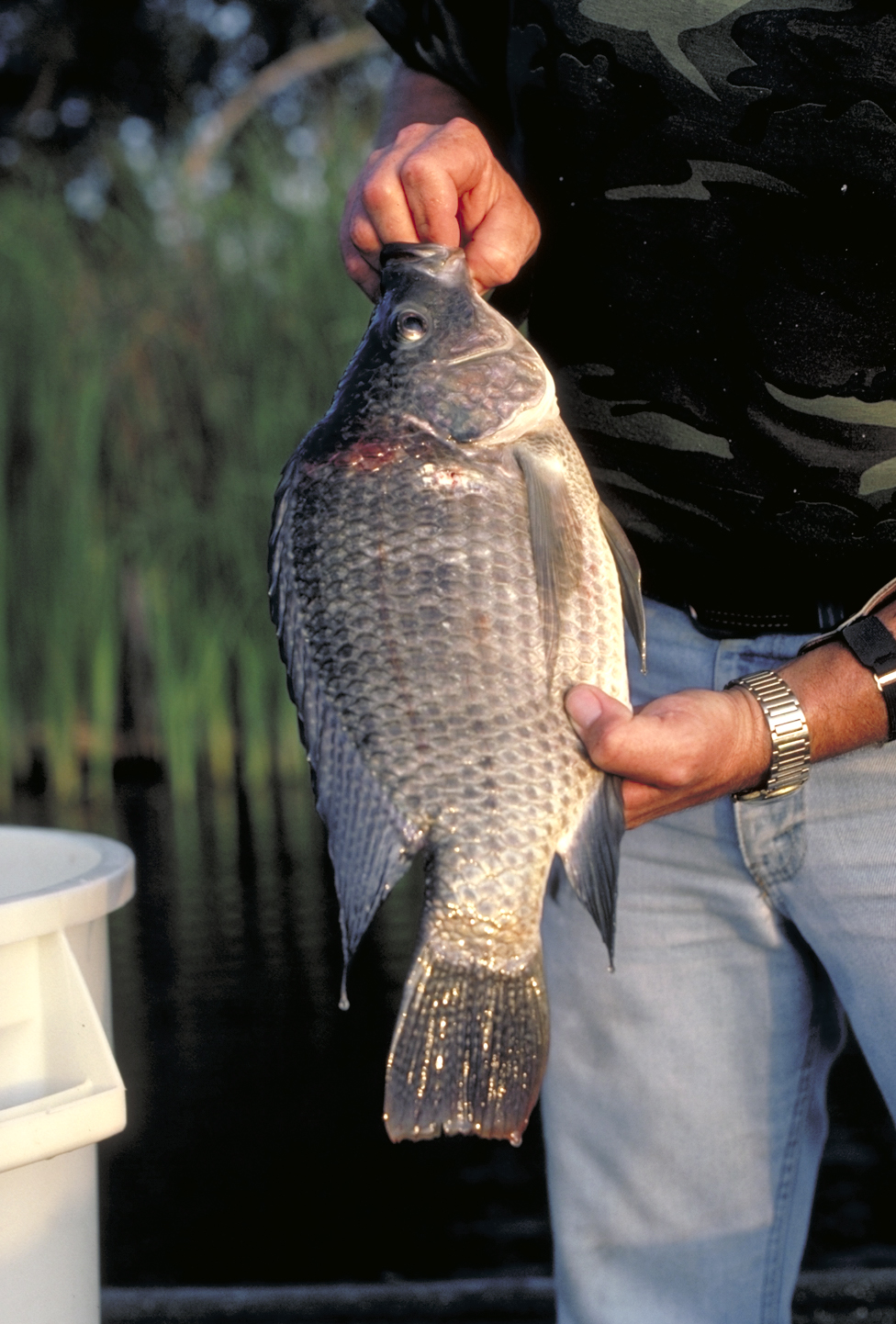
Blue tilapia
This is Passport to Texas
When you hear the word tilapia, you may think of a savory meal with lemon butter sauce, but you probably don’t think of the term “invasive species.”
Tilapia are great to eat. They’re raised as a food fish, and they’re quite tasty. They’re quite popular in restaurants. But the problem is when they’re in our natural waters they are upsetting the ecosystem.
Originally established in fish farms as a food source, Tilapia eventually found their way into Texas waters.
Gary Garrett, a former Texas Parks and Wildlife fisheries biologist, says tilapia pose a threat to large mouth bass and other native species.
They build big pit nests and in doing that they stir up a lot of the sediment. And it’s been shown, for example, with large mouth bass, all that sediment stirred up and settling back down will often kill largemouth bass eggs.
And because of the delicate nature of the food chair, this behavior has the potential of damaging the entire ecosystem.
TPW has regulations for tilapia, but because they’re widespread statewide, they are difficult to control. But if you like to fish, Garrett says, there’s one way you can help.
Don’t throw them back. If you catch them, keep them.
So, next time you reel in tilapia, turn on the grill and get cooking.
The Sport Fish Restoration Program supports our series.
For Texas Parks and Wildlife…I’m Cecilia Nasti
Posted in Fishing, Food, Freshwater, Texas Invasives, Tilapia | Comments Off on Tilapia: Detrimental and Delicious
July 25th, 2018
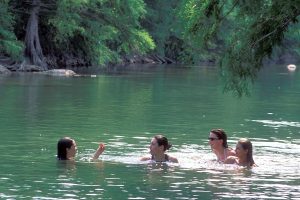
Swimming at State Parks.
This is Passport to Texas
You don’t have to hunker down indoors as the temperatures continue to climb. Many state parks offer a cool alternative to air-conditioned cabin fever with a number of natural swimming holes…
Public swimming pools can be fun if you like noise and crowds. If you prefer peaceful playtime, float your cares away at Blanco State Park, 40 miles north of San Antonio. Here you’ll find cool, clear, spring-fed swimming for anyone seeking refuge from the long Texas summer.
Located about one hour from Fort Worth, Dinosaur Valley State Park allows visitors to swim in the same Paluxy River where dinosaurs roamed 113-million years ago.
Garner State Park near Uvalde is home to 10 acres of Frio riverfront, giving visitors plenty of space to swim the clear water, scoot the rapids in inner tubes, or even rent pedal boats.
Find listings of river and creek swimming sites at state parks at texassrtateparks.org. You’ll also find a list of sites with lake swimming, and even some with ocean swimming.
Or, if you prefer swimming pools, there’s a directory of parks offering those controlled environments to beat the heat. No matter where you decide to take a dip: don’t forget your sunscreen!
That’s our show for today. For Texas Parks and Wildlife, I’m Cecilia Nasti.
Posted in State Parks, Swimming | Comments Off on Cool Off with a Swim at a Texas State Park
July 24th, 2018
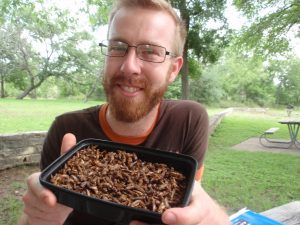
Little Herds’ Robert Nathan Allen with toasted crickets.
This is Passport to Texas
Experts predict the world’s population will increase to nine billion people by 2050. That’s two billion more mouths to feed. And Robert Nathan Allen says an eco-friendly protein to help nourish the masses is insects.
Compared to say a cow, where we can only really eat about forty percent of the cow, with insects; we can eat most if not all of them.
Allen founded the nonprofit Little Herds to educate the public about insects as a nutritious alternative food source. Insects are high in protein and rich in fiber micronutrients. Currently 70% of agricultural land supports meat production, which limits the industry’s future growth.
So, with insects, we can raise them in a modular fashion vertically on a fraction of the land as traditional livestock, with a fraction of the water, with a fraction of the feed, and end up with more nutritional valuable protein.
It’s a huge leap from eating burgers to bugs. For the brave ones, Allen recommends obtaining edible insects from farms that raise them for human consumption.
That way we can assure that they’re raised in a hygienic, safe, clean environment. We can make sure that there’s no risk of diseases and parasites, and we can make sure tht they’re eating a clean, wholesome diet.
According to a UN report, over 2 billion people worldwide already supplement their diet with insects. Intrigued? Learn more about edible insects at littleherds.org.
For Texas Parks and Wildlife, I’m Cecilia Nasti.
Posted in Entomophagy, Food | Comments Off on Can Eating Insects Save the World?
July 23rd, 2018
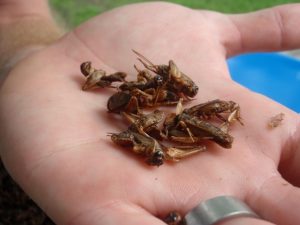
A handful of tasty, toasted crickets.
This is Passport to Texas
Bugs have a way of showing up just as you unpack your picnic. But what if you welcomed their presence? No, not as guests… as snacks.
They really do have a crunch [crunches]; really similar to roasted nuts.
That’s Robert Nathan Allen, who was just then crunching a toasted cricket. He’s founder of the Austin, Texas nonprofit Little Herds.
And we focus primarily educating the public and particularly children about edible insects and why and how we can adopt them into our diet.
We call eating insects as food Entomophagy; it’s commonplace among 80% of the world’s population. But we westerners steer clear.
Once western societies started becoming very agriculturally based, particularly in northern climates, it just became ingrained in our society that insects are dirty. And so, that idea has continued to be passed down generation to generation in these western cultures. Whereas in the tropical environments where the habit has continued, it’s just another food source.
The thing is, we already eat more than 400 insects a year without knowing it. Allen says by intentionally switching animal protein for insect protein, we can improve the environment and our nutrition. More on that tomorrow.
Our show receives support in part from RAM Trucks: built to serve.
For Texas Parks and Wildlife, I’m Cecilia Nasti.
Posted in Entomophagy, Food | Comments Off on Insects–They’re What’s for Dinner







 Passport to Texas is a
Passport to Texas is a  Passport to Texas is made available by:
Passport to Texas is made available by: